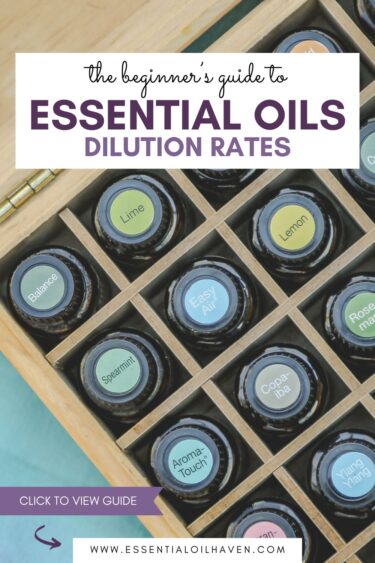
When it comes to essential oils, more is not always better! Proper essential oil dilution is key to ensuring safe and effective use, whether you’re making a soothing roller blend, a nourishing face serum, or a relaxing massage oil. But how much essential oil should you actually use?
If you’ve ever wondered how to dilute essential oils correctly—or felt overwhelmed by all the different ratios—you’re in the right place. This beginner’s guide breaks down everything you need to know about dilution rates, including how to mix essential oils with carrier oils for different applications.
This post contains affiliate links, which means if you make a purchase through these links, I may receive a small commission at no extra cost to you. Read my full disclosure policy here.
Whether you’re crafting blends for adults, children, or sensitive skin, you’ll find easy-to-follow guidelines to help you get it just right.
Let’s dive in and take the guesswork out of essential oil dilution!
Why Diluting Oils Is Important
We love our essential oils. Why? Because they smell amazing, are highly medicinal, and can work wonders on promoting health and wellness.
All essential oils have the potential to boost health and wellness, either by diffusing or through topical use (you can also ingest them), but each essential oil like the plants, trees, flowers and fruits that provide for them, are different. Some essential oils have stronger qualities than others and affect us in different ways, and some can be milder than others. All oils require dilution with a carrier oil when used topically on the skin.
Lavender essential oil, for example, is one of the most versatile essential oils for use of promoting health and wellness and it is considered one of the gentlest essential oils – it’s still recommended to dilute it to stay safe. Lemon essential oil contains compounds that could irritate the skin if used without dilution. It is highly recommended to follow precautions when using it – I almost never apply it to my skin, even with a carrier oil. Lavender, however, is my best friend of all the essential oils and I always dilute it with coconut oil before applying it to my skin.
The fact is: these lovely gifts from nature are concentrated, highly volatile oils that we need to treat with care and respect.
This essential oil dilution guide is designed to help you understand essential oil dilution rates and use your oils safely at home.
Essential Oil Dilution for Kids

Kids are intrigued by essential oils – but use them with caution around the little ones.
Children respond well to essential oils and they love them. They are a great go-to to help relax a temperamental child; during cold and flu as care and prevention; hair and skin care and a lot more. But using essential oils on children requires special caution and dilution is always necessary.
“The majority of cases of essential oil poisoning involve accidents with young children, often between 1 and 3 years of age. Approximately 75% of cases in the USA are in children up to 6 years old,” – quoted from www.thehippyhomemaker.com
All essential oils should be kept out of the reach of children. Certain oils are toxic. Children should never ingest essential oils. Experts at Young Living recommend never using an essential oil on children younger than 2 (babies).
Shirley Price is an aromatherapist and author of the book, “Aromatherapy for Babies and Children.” In the Essential Oils Quick Reference Guide, written by Connie and Alan Higley, Shirley Price is referenced as recommending 20 essential oils that are safe for children including:
- Bergamot, Cedarwood, Chamomile, Cypress, Frankincense, Geranium, Ginger, Lavender, Lemon, Mandarin, Marjoram, Melaleuca-Tea Tree, Orange, Rose Otto, Rosemary, Rosewood, Sandalwood, Thyme, Ylang, Ylang
- A dilution rate of 0.5% is recommended for infants 6-24 months of age. Please consult with a Certified Aromatherapist or medical professional before using essential oils on children. Be aware of “hot” oils such as Oregano, Clove Bud or Cinnamon. Hot oils should not be used on children under the age of 10.
- 1% dilution rate for children age 2 – 10, the elderly, people with sensitive skin, or facial applications. Stay on the conservative side, start low, and monitor skin tolerance.
Higley recommends diluting 1 – 2 drops of pure essential oil with ½-1 tsp mixing oil and recommends always using a bath gel base as a “dispersing agent” for the oils.
“If an oil is ever ingested, give the child an oil-soluble liquid such as milk, cream, or half and half. Then call your local poison control center or seek emergency medical attention,” – Higley
Learn more Want more details? Check out the Essential Oils for Kids Full Guide
Essential Oil Carrier Oils
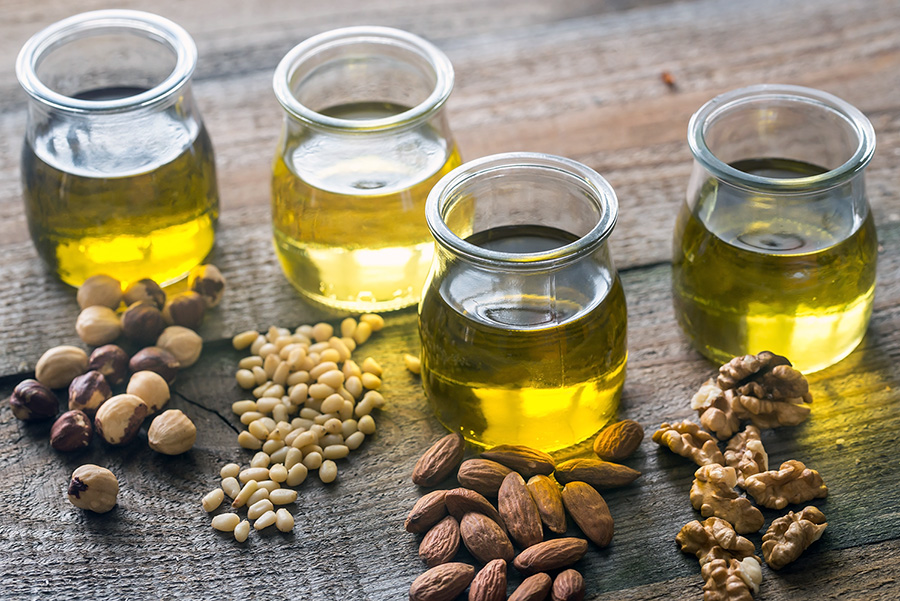
Glass jars showing different kinds of nut oils. Carrier oils are fatty oils used to dilute the potency of 100% pure essential oils.
When it comes to carrier oils, there are a lot to choose from.
In the Complete Book of Essential Oils and Aromatherapy, author Valerie Ann Worwood explains that it is important to use high quality vegetable oils (plant-based oils, such as, nut, kernel, seed or flower), that are pure, organic and natural.
A good carrier oil should be free of scents and synthetic, petroleum products.
A Few Carrier Oils Explained
There are many amazing carrier oils to choose from. They will help your essential oils last longer and cover more ground during massages, or when using them as creams, hair or bath products.
- Almond Oil: Almond oil is a great choice. It softens, moisturizes and nourishes the skin and can be used on all face and body skin types, including sensitive, inflamed, and infected skin. It can be used for various purposes, including to ease dry skin, itch and inflammation. It also contains vitamins E and K, omegas 9 and 6 fatty acids.
- Coconut Oil: Coconut oil is described as a nourishing, protective oil that softens and sooths skin. It’s great for dry and dehydrated skin and helps to ease irritation, itching, un damage, softening and smoothing and amazing for hair care. Recipes for use of coconut oil with essential oils include body oils, balms and ointments. I’ve also made hair masks with the use of coconut oil. Since it hardens when cool, it’s also great for Winter lip balm recipes. In the summer I have made coconut oil sprays to help ward off and ease sunburns. See recipes below.
- Hemp Seed Oil: Hemp seed oil has firming, moisturizing, and anti-inflammatory qualities. It’s great for use in recipes for mature skin, combination skin, dryness and itching. It contains omegas 3, 6 and 9 fatty acids. Hemp seed oil makes a great carrier oil for body and face oils, ointment, gels and hair care.
- Grape Seed oil: Grape seed oil is restorative, smoothing and restructuring. It can be used on all skin types, including those that are prone to pimples. Use with your essential oils in recipes for massage, dehydration and for moisturizing and soothing the skin. It contains vitamin E, omegas 6 and 9 fatty acids.
Other oils you can consider using include: Argan Oil, Halzelnut Oil, Jojoba Oil, Rice Bran Oil, Safflower Oil, Sunflower Oil, Olive Oil, Avocado Oil, Cocoa Butter, and Shea Butter can also be used.
Learn more More details in the Full Carrier Oils Guide
Dilution Rate Chart for Essential Oils in Carrier Oil
The following chart is a guide you can use to help you dilute your essential oils into your favorite carrier oil. Since essential oils are concentrated, a little can go a long way. With this chart you get to create your own recipes based on your preferences for scent and strength. The usual recommendation is to dilute at 2%-3% for regular, healthy adults. 5% is only recommended for short term use under the guidance of a Certified Aromatherapist.
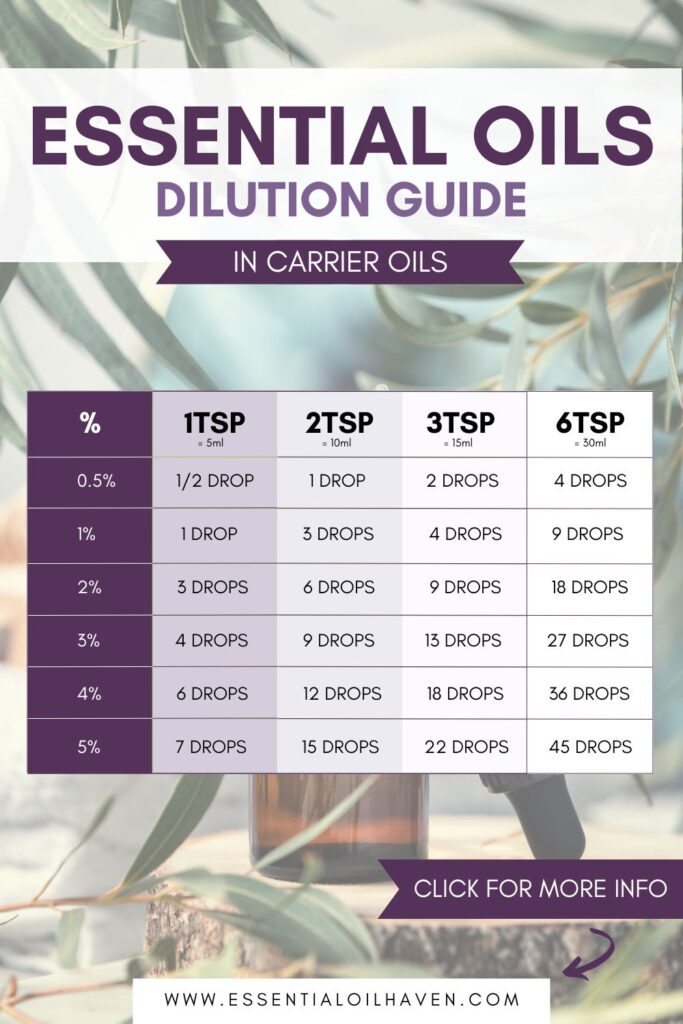
| Dilution % | 5 ml Bottle
(=1 tsp carrier oil) |
10 ml bottle
(=2 tsp carrier oil) |
15 ml bottle
(=3 tsp carrier oil) |
30 ml bottle
(=6 tsp carrier oil) |
| 0.5% | Less than 1 drop | 1 drop | 2 drops | 4 drops |
| 1% | 1 drop | 3 drops | 4 drops | 9 drops |
| 2% | 3 drops | 6 drops | 9 drops | 18 drops |
| 3% | 4 drops | 9 drops | 13 drops | 27 drops |
| 4% | 6 drops | 12 drops | 18 drops | 36 drops |
| 5% | 7 drops | 15 drops | 22 drops | 45 drops |
Source: https://www.rockymountainoils.com/dilution-rate/
Dilution Rate Chart for Essential Oils in Diffuser
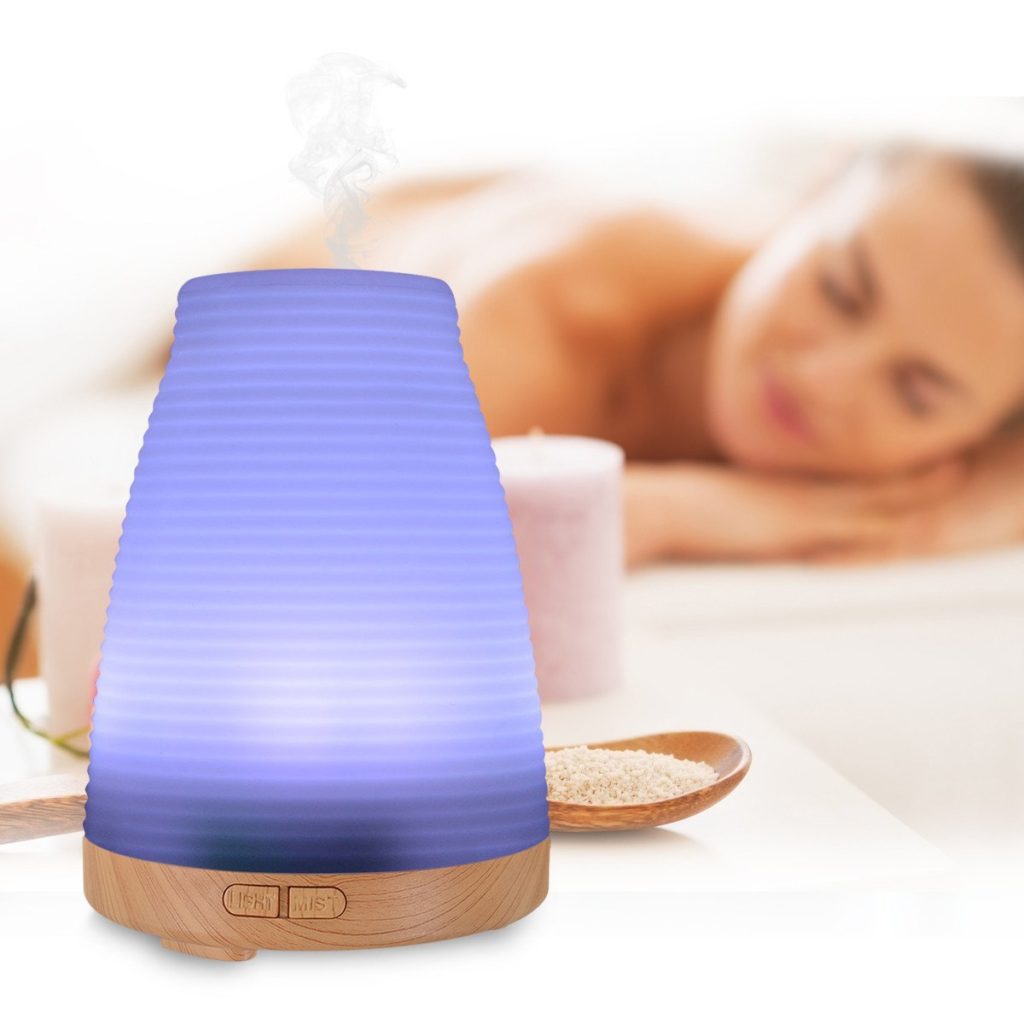
Essential Oil Diffusers create an aromatic experience at home.
Are you wondering how many drops of essential oil you should put in your diffuser? Diluting essential oils in a diffuser properly is not a one-size-fits-all solution. To stay within safe measures, first you need to know the water tank size of your diffuser. Most essential oil diffusers range between 100 mL to 500 mL in size. The 100 mL size is quite common in starter units and smaller devices, and if you have a larger unit, you’ll probably know.
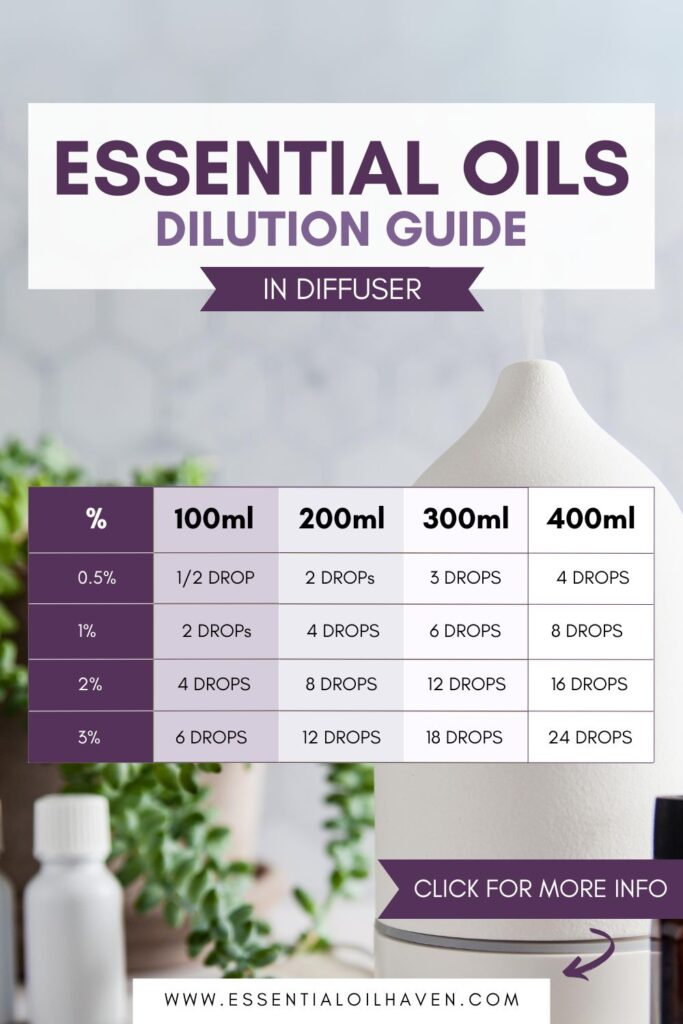
Here is an easy chart on how many drops of essential oils to use in your diffuser:
| Dilution % | 100 mL | 200 mL | 300 mL | 400 mL | 500 mL |
| 0.5 | Less than 1 drop | 2 drop | 3 drops | 4 drops | 5 drops |
| 1 | 2 drops | 4 drops | 6 drops | 8 drops | 10 drops |
| 2 | 4 drops | 8 drops | 12 drops | 16 drops | 20 drops |
| 3 | 6 drops | 12 drops | 18 drops | 24 drops | 30 drops |
In Summary
The options are endless when it comes to creating your own recipes using essential oils. Now that you have your very own beginners guide on diluting essential oils to get you started, you can have fun using your favorite oils in a safe way that will help save you money and build your own essential oil recipe box.
I would love to know your favorite recipes and how these dilution rates are working for you. Join our conversation on Facebook or leave your comments below this guide.

